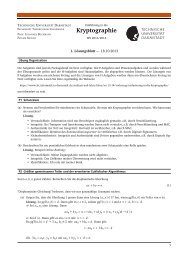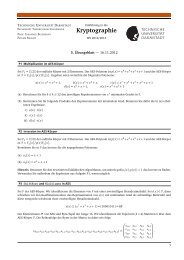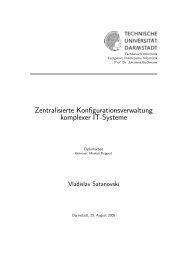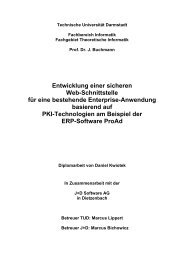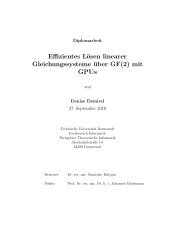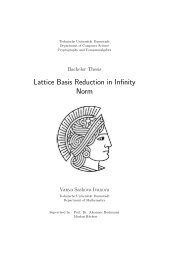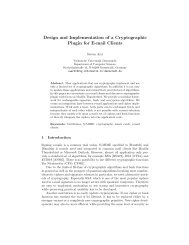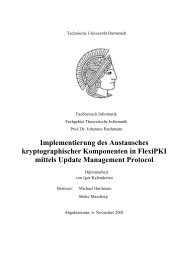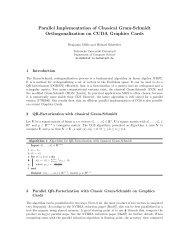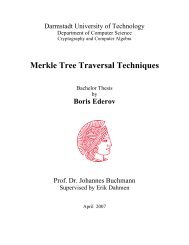An efficient mobile PACE implementation - CDC
An efficient mobile PACE implementation - CDC
An efficient mobile PACE implementation - CDC
Create successful ePaper yourself
Turn your PDF publications into a flip-book with our unique Google optimized e-Paper software.
Streamlining.<br />
To obtain even more performance improvement we avoid<br />
heavy Java objects whenever possible. Instead, most values are<br />
represented by basic data structures to avoid the expensive object<br />
creation and handling which is particularly important on resource<br />
constrained environments such as <strong>mobile</strong> phones.<br />
4.3 Multiplication Algorithms<br />
In the following three paragraphs we describe how to speed up<br />
the 5 necessary point multiplications from Equations (1) and (4) to<br />
(13) using the findings from Section 3 and 4.1.<br />
Equation (1).<br />
In Section 4.1 we saw that Equation (1) has to be solved before<br />
all other equations. With the random number x and the fix basepoint<br />
G (that can be permanently stored after the first contact with<br />
the eID card) the Lim-Lee multiplication algorithm performs best<br />
according to Table 4. This is quite clear as the values precomputed<br />
during the Lim-Lee algorithm can be stored permanently on the<br />
<strong>mobile</strong> phone and can be reused to speed up the calculation. Therfore<br />
we choose Lim-Lee multiplication to evaluate Equation (1)<br />
X = x · G. The computation can be started in a low priority thread<br />
before the PIN is entered or even before the <strong>mobile</strong> device has contact<br />
to the eID card.<br />
Equations (4) & (6) / (4) & (7) / (8) & (9) / (10)-(13).<br />
For the calculation of G ′ and � SKPCD we have different possibilities<br />
according to the rearranged equations explained in Section 4.1.<br />
For the calculations of the product-sum of Equation (6) or alternatively<br />
Equation (7) we use interleaving which performs best with<br />
Y randomly chosen every session (cf. Table 6). As G ′ is different<br />
in each session the additional point multiplication with � SKPCD in<br />
Equation (4) is done with a simple w-NAF multiplication (cf. Table<br />
1). Alternatively, � P KPCD could be implemented using Equation<br />
(8) or (12). The evaluation of the product-sum of Equation (8) is<br />
implemented using an interleaving multiplication algorithm again<br />
based on the performance calculations in Table 6. While Equation<br />
(12) is a simple addition Equation (10) is implemented using a Lim-<br />
Lee multiplication and Equation (11) using a simple w-NAF multiplication.<br />
The necessary additional calculation of G ′ with Equation<br />
(9) resp. (13) is done with a w-NAF multiplication again. Here we<br />
implement all four variants α − δ to compare them with each other<br />
as the theoretical results can not decide exactly which one is the<br />
best.<br />
Equation (5).<br />
Since � P KPICC changes every session, off-line precomputations<br />
and permanent storage of precomputed points are not possible for<br />
the point multiplication from Equation (5). According to Table 1<br />
the w-NAF algorithm performs best in that case and therefore is<br />
chosen for the calculation.<br />
5. IMPLEMENTATION<br />
We implement the <strong>PACE</strong> protocol as a Java ME application and<br />
test it on the <strong>mobile</strong> phone Nokia 6212 3 . The connection between<br />
the PICC and the PCD (<strong>mobile</strong> phone) is enabled by the NFC interface<br />
and the data transmission proceeds by using Application<br />
Protocol Data Units (APDU) specified in ISO/IEC 7816 [20] and<br />
3 Currently (Dec. 2010) the Nokia 6212 is the only NFC-enabled<br />
cell phone available in Germany.<br />
Bouncy Castle FlexiProvider<br />
Details PCD Total PCD Total PICC<br />
1 424 676 274 530 256<br />
2 459 1266 597 1261 134<br />
b D(Kπ, z) 19 1396 253 1631 98<br />
c x · G 5667 7724 968 3346 731<br />
d x · Y 5582 19006 797 5053<br />
e s · G 4819 23851 244 5307<br />
(d) + (e) 19 1<br />
f � SKPCD · G ′ 5600 35450 889 7644 535<br />
i � SKPCD · � P KPICC 5564 41026 1666 9333<br />
j TPCD 42 41160 22 9458 87<br />
Total [ms] 28195 41160 5718 9458 1841<br />
Table 8: Reference <strong>PACE</strong> performance test on Nokia 6212<br />
Bouncy Castle FlexiProvider<br />
Details PCD Total PCD Total PICC<br />
1 EF.CardAccess 120 381 100 390 290<br />
2 MSE:Set AT 50 581 100 651 161<br />
b D(Kπ, z) 10 661 50 761 60<br />
c x · G 171 1172 70 1181 350<br />
d x · Y 20 1212 10 1211<br />
e s · G 20 1232 10 1221<br />
(d) + (e) 0 0 0<br />
f � SKPCD · G ′ 30 1553 20 1512 261<br />
i � SKPCD · � P KPICC 20 1562 40<br />
j TPCD 10 1663 0 1622 60<br />
Total [ms] 451 1663 400 1622 1182<br />
Table 9: Reference <strong>PACE</strong> performance test on desktop PC<br />
TR-03110 [11]. For the required cryptographic functions, which<br />
are out of scope of the Java ME platform, we use external cryptographic<br />
libraries such as FlexiProvider 4 and Bouncy Castle 5 . These<br />
two currently seem to be the only available CSPs for elliptic curve<br />
arithmetic on <strong>mobile</strong> devices. Other providers like IAIK 6 cannot<br />
perform elliptic curve cryptography in a <strong>mobile</strong> environment<br />
or are just out of date (e.g. Cryptix 7 ). The CSPs are used for<br />
the key derivation, decryption of the nonce s, the map function<br />
(Generic Mapping), and the key generation. The domain parameters<br />
D (stored in the file EF.CardAccess on the PICC) include a set<br />
of Security Infos [11], which defines the ECC domain parameters,<br />
the common base point G, and the supported encryption algorithm.<br />
The data is encoded in Abstract Syntax Notation One (ASN.1) data<br />
structures as specified in [11]. Bouncy Castle includes an ASN.1<br />
parser to decode the data structures, the FlexiProvider uses the<br />
CoDec 8 library developed by Fraunhofer IGD.<br />
5.1 Reference Tests<br />
In order to have reference timings, we first implemented the<br />
<strong>PACE</strong> protocol in a straightforward manner without any improvements<br />
or optimizations described in Section 4. The measurements<br />
of the respective performance tests are depicted in Table 8. Step (1)<br />
shows the values for selecting and reading the file EF.CardAccess<br />
(Select File and Read Binary command [20]), and decoding the<br />
ASN.1 data structures. Step (2) shows the initialization of <strong>PACE</strong><br />
by using the MSE:Set AT command [11]. Steps (b) to (j) correspond<br />
to the steps depicted in Figure 1. The key derivation in the<br />
steps (a), (h) and (i) are simple hash computations. Therefore, their<br />
4 http://www.flexiprovider.de<br />
5 http://www.bouncycastle.org<br />
6 http://jce.iaik.tugraz.at<br />
7 http://www.cryptix.org<br />
8 http://codec.sourceforge.net





